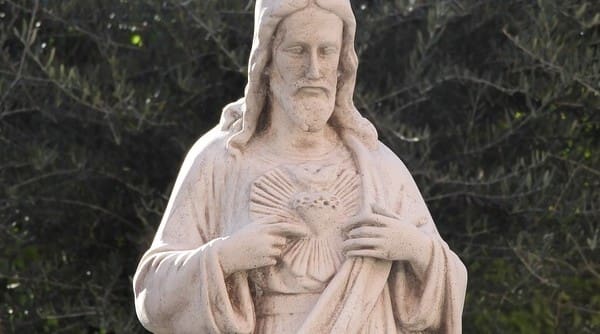The tradition of Salesian spirituality, in which St. Margaret Mary figures prominently, offers a view of life both optimistic and real. The dominant metaphor in this vision pictures a world of interconnected hearts—human and divine—to express the harmonious state of life and love to which human beings are eternally destined. But, as is clear from human history, we have not yet arrived there; in fact, as our own experience demonstrates, we have a long way to go.
Still, our journey to eternal life has begun and has been set on the right course thanks to God’s “visitation” of this world in the person of His Son, Jesus. In His life, death, Resurrection, and Ascension, we discover all that we need for our eternal salvation. Particularly in His Passion on Calvary, where His Sacred Heart is pierced open to pour out the full graces of redemption, we find what St. Francis de Sales describes as a “school of love” for Christian wisdom.
Prayerfully incorporating his motto for the devout life, the saint concludes his masterful Treatise on the Love of God with this mystical summary of the devout life:
O love eternal, my soul needs and chooses you eternally! Ah, come Holy Spirit, and inflame our hearts with your love! To love—or to die! To die—and to love! To die to all other love in order to live in Jesus’ love, so that we may not die eternally. But that we may live in your eternal love, O Savior of our souls, we eternally sing, “Live, Jesus! Jesus, I love! Live, Jesus whom I love! Jesus I love, Jesus who lives and reigns forever and ever. Amen.” (Treatise, 12:13)
That mysticism comes to full display in devotion to the Sacred Heart of Jesus. Born of the visionary experiences of St. Margaret Mary Alacoque, the devotion enables us to comprehend the love of Christ for humanity by looking upon that sacred image and icon.
Jesus Himself tells us as much—in the only Gospel reference in which He describes the makeup of His Heart to us: “Come to me, all who labor and are heavy laden, and I will give you rest. Take my yoke upon you, and learn from me, for I am gentle and lowly in heart, and you will find rest for your souls. For my yoke is easy, and my burden is light” (Matt. 11:28–30).
Frequently cited in the corpus of St. Francis de Sales’s writings, this alluring invitation serves as the cornerstone to the edifice of Salesian spirituality. As Wendy Wright explains:
The invitation to learn from, to imitate, to follow, to be as Jesus receives the stress. And what is Jesus like? He is gentle and humble of heart. That is, the core of his being, his most essential self, the point from which all actions and thoughts flow—the heart—has the qualities of gentleness and humility. For Francis this was a radically countercultural idea, for most hearts are not gentle and humble but proud, grasping, and envious. . . . For him, this truth had eschatological significance, for Jesus the Christ came to overturn the standards of the world and enflesh a new standard of reality. Gentleness and humility were signs of the presence of the kingdom.85
Through meditative prayer, we tap into this new reality and respond to the divine plea by listening to what Jesus wishes to reveal to His own “little children.” He says, “Come to me,” to those who desire happiness—not to the self-proclaimed and self-serving followers of secular culture, whose perspectives are limited to this world. To those who seek meaning in life, He insists, “Learn from me”—rather than trusting in partial human knowledge and being guided by passions and inclinations, fickle as these will be. He can claim, “I am gentle,” for His deeds show love and mercy shared with all the world, despite our indifference toward Him and our sins against Him. And He rightly identifies Himself as “lowly in heart,” for He has need of nothing for Himself, but wants only for us to know how much we are loved and for us to return love for love by how we treat one another.
That love, which alone gives rest for our souls, comes from Him who revealed His Heart to St. Margaret Mary, “with all Its treasures of love, mercy, grace, sanctification, and salvation. This He did,” she writes, “in order that those who were willing to do all in their power to render and procure for Him honor, love, and glory might be enriched abundantly, even profusely, with these divine treasures of the Heart of God, which is their source.”
+
This article is adapted from a chapter in Behold This Heart by Fr. Thomas Dailey which is available from Sophia Institute Press.

Art for this post on the Sacred Heart: Cover and featured image used with permission.




